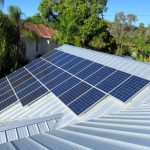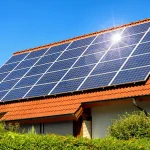You may have noticed that your energy bill includes terms like “off-peak electricity hours” and “peak” usage. You may have also observed that the electricity rates vary based on consumption and time of day.
In essence, off-peak and peak electricity hours have an impact on your daily energy costs. Let’s delve into what this all entails.
What Are Peak And Off-Peak Electricity Hours?
So, what exactly are peak hours for electricity? Well, when it comes to electricity, peak hours (and off-peak hours) are essentially the opposite. Allow us to explain.
Understanding how off-peak and peak electricity hours affect your energy bill is crucial for both solar and non-solar homeowners, as well as ratepayers. Why is this important? Having a grasp of the basics empowers you as an energy consumer to develop strategies for more efficient and cost-effective energy usage.
For solar homeowners, one such strategy is implementing a “time-of-use” (TOU) plan, which can also accelerate the payback period of your solar investment.
Understanding Peak Electricity Hours
Before we delve deeper into what peak electric hours entail, it’s important to understand one thing. Energy producers are required to provide a minimum amount of power to the electrical grid at any given time.
Whether a power plant is fueled by gas, coal, nuclear energy, or renewable sources, it must allocate and transmit a certain percentage of generated energy to the grid. This minimum power requirement for utilities is known as the “base load.”
However, electricity demand fluctuates throughout the day, and utilities charge different usage rates based on the time of day.
By analyzing historical energy usage patterns, utility companies can identify the times when residential homes have the highest energy demands.
Unsurprisingly, residential energy demand peaks when people are at home, awake, and active. During the week, peak usage can occur in the mornings and afternoons, when people wake up or return home from work and school.
These periods of high energy demand are referred to as “peak” electricity hours. They hold greater significance than meets the eye — excessive demand can strain the grid and lead to energy blackouts. Consequently, utilities impose higher electricity rates during peak TOU.
TOU: How Does It Work?
Many utilities divide TOU into three periods, which may vary depending on the company, operating region, and season. Here are the primary TOU time frames:
- Peak electricity hours: Weekdays between 5:00 p.m. and 8:00 p.m., and on weekends
- Mid-peak hours: Transitional period between peak and off-peak hours
- Off-peak electricity hours: Typically weekdays before 4:00 p.m. and after 9:00 p.m.
Aligning the cost of electricity with TOU enables utility companies to influence consumer behavior and maintain the integrity of the electrical grid.
For instance, if someone is aware that running a dishwasher during peak electric hours may cost up to three times more, they will (hopefully) opt to run it during off-peak electric hours. This, in turn, assists their utility company in managing power demand.
Off-Peak Time-of-Use (TOU) and Savings on Rates
Off-peak hours for electricity refer to the periods when the demand for power is low, resulting in reduced costs for consumers. During these off-peak electric hours, utilities and power producers incur lower generation expenses due to the decreased overall power demand. However, when the demand rises, grid operators request additional electricity from producers. If electricity generators cannot increase production quickly enough, utilities are then compelled to purchase extra electricity from other sources. Consequently, this leads to higher wholesale energy prices and subsequently higher electricity rates for consumers.
Implications of Peak Usage and Off-Peak Usage for Solar Consumers
Electricity rates for grid-tied solar panels, also known as hybrid solar panels, vary according to utility company, region, and rate plans. For instance, under a TOU plan, a utility company may estimate that the cost per kWh for solar power is roughly half that of a nonsolar consumer. However, the savings are diminished if a solar consumer consumes excessive energy during peak electricity hours.
Of course, there is an opportunity for solar consumers to reduce their energy bills if a utility company has implemented a net metering policy. In this scenario, utilities credit solar consumers for the surplus solar power they generate but do not use. This is where solar storage batteries come into play.
The Role of Solar Batteries
Solar consumers should consider incorporating battery storage, such as the Tesla Powerwall, into their home solar systems to effectively manage TOU and avoid peak charges. During off-peak periods, solar panels charge the battery, which can then be utilized during electric peak hours, thus helping to avoid peak charges and minimize strain on the grid.
Peak and off-peak usage plans also facilitate the transition to cleaner energy sources in certain states. By implementing TOU plans, utilities can incentivize consumers to consume less energy during periods of lower solar generation and more energy when solar generation is at its peak. Consequently, solar consumers reduce their overall dependence on carbon-based energy sources.
The Bottom Line
For both solar and non-solar homeowners, the most cost-effective electricity usage lies outside the mid-peak and peak electricity hours. Aligning the timing of lighting, appliance usage, and HVAC operation around these hours carries several benefits, including:
- Avoiding peak TOU charges
- Shorter payback timelines for infrastructure investments
- Assisting utilities and operators in better grid maintenance
Contact Region Solar + Electric For Efficient Solar Power Systems For Residential And Commercial Properties
Whether you generate power during off-peak or peak electricity hours, Freedom Solar Power is always here to support your energy generation needs. To begin harnessing the power of solar energy, please call us at (941) 355-6565 or complete our online inquiry form. An energy consultant will be in touch with you for a free consultation and quote!





